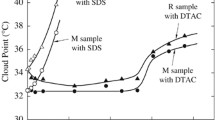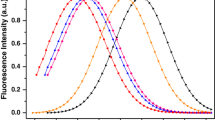Abstract
The solubilization sites of aniline and its derivatives in micelles were investigated with fluorescence probe technique. The fluorescence probes employed in this study are 12-(9-anthroyl) stearic acid (AS) and 2-p-toluidinylnaphthalene-6-sulfonate (TNS) which are incorporated in the interior of the micelle and attached to its surface, respectively. As these two probes were effectively quenched by aniline and its derivatives, the modified Stern-Volmer relationship in micellar system could be applicable to estimate the partition coefficient, K p of the solubilizate between aqueous and micellar phase. Because K p derived by this method reflects the relative proximity of the fluorophore to the quencher, the ratio of K p in the surface area to that in the interior of the micelle is interpreted in terms of the relative location of the solubilizate in micellar aggregate. The results show that the solubilizates are not located in a definite position but distributed in the multiple-sites of the micelle. The solubilization sites of the solubilizates in the micelle are dependent on their structures. As the solubilizate has more numbers of N-substituents of aniline and more numbers, of carbon in the substituent, it tends to incorporate in the interior of the micelle more effectively.
Similar content being viewed by others
Literature Cited
Mittal, K.L. and Fendler, E.J.: “Solution Behavior of Surfactants”, Vol. 1, Plenum Press, New York, p. 15 (1982).
Matsuo, T., Yudate, K. and Nagamura, T.: NMR and paramagnetic-and fluorescent-probe studies on solubilization site in cationic surfactant micelles containing phenoxy groups.J. Colloid Interface Sci. 83, 354 (1981).
Eriksson, J.C. and Gillberg, G.: NMR-studies of the solubilisation of aromatic compounds in cetyltrimethylammonium bromide solution II.Acta Chem. Scand. 20, 2019 (1966).
Fendler, J.H., Fendler, E.J., Infante, G.A., Shih, P. and Patterson, L.R.: Absorption and photon magnetic resonance spectroscopic investigation of the environment of acetophenone and benzophenone in aqueous micellar solutions.J. Am. Chem. Soc. 87, 89 (1975).
Jobe, D.J., Reinshorough, V.C. and White, P.J.: Solubilization sites in micellar sodium octylsulphate solutions by ultrasonic spectroscopy.Can. J. Chem. 60, 279 (1982).
Elworthy, P.H., Florence, A.T. and Macfarlene, C.B.: “Solubilization by surface-active agents and its applications in Chemistry and Biological Sciences”, Champman and Hall, London, p. 61 (1968).
Cardinal, J.R. and Mukerjee, P.: Sol, nt effects on the ultraviolet spectra of benzene derivatives and naphthalene. Identification of polarity sensitive spectral characteristics.J. Phys. Chem. 82, 1614 (1978).
Mukerjee, P. and Cardinal, J.R.: Benzene derivatives and naphthalene solubilized in micelles. Polarity of microenvironment, location and distribution in micelles, and correlation with surface activity in hydrocarbon-water systems.J. Phys. Chem. 82, 1620 (1978).
Pownall, H.J. and Smith, L.C.: Viscosity of the hydrocarbon region of micelles. Measurement by excimer fluorescence.J. Am. Chem. Soc. 95, 3136 (1973).
Kalyanasundaram, K. and Thomas, J.K.: Environmental effects on vibronic band intensities in pyrene monomer fluorescence and their application in studies of micellar systems.J. Am. Chem. Soc. 99, 2039 (1977).
Turro, N.J. and Yekta, A.: Luminescent probes for detergent solutions. A simple procedure for determination of the mean aggregation number of micelles.J. Am. Chem. Soc. 100, 5951 (1978).
Almgren, M. Grieser, F. and Thomas, J.K.: Dynamic and static aspects of solubilization of neutral arenes in ionic micellar solutions.J. Am. Chem. Soc. 101, 279 (1979).
Chalpin, D.B. and Kleinfeld, A.M.: Interaction of fluorescence quenchers with the n-(9-anthroyloxy) fatty acid membrane probes.Biochim. Biophys. Acta. 731, 465 (1983).
Azzi, A.: The application of fluorescent probes in membrane studies.Quarterly Reviews of Biophysics 8, 237 (1975).
Koblin, D.D., Pace, W.D. and Wang, H.H.: The penetration of local anesthetics into the red blood cell membrane as studid by fluorescence quenching.Arch. Biochem. Biophys. 171, 176 (1975).
Sikaris, K.A., Thulborn, K.R. and Sawyer, W.H.: Resolution of partition coefficients in the transverse plane of the lipid bilayer.Chem. Phys. Lipids 29, 23 (1981).
Jain, M.K. and Wagner, R.C.: “Introduction to Biological Membranes”, Wiley, New York, p. 67 (1980).
Ekwall, P., Mandell, L. and Solyom, P.: The aqueous cetyltrimethylammonium bromide solutions.J. Colloid Interface Sci. 35, 579 (1971).
Blatt, E., Ghiggino, K.P. and Sawyer, W.H.: Fluorescence depolarization studies of n-(9-anthroyloxy) fatty acids in cetyltrimethylammonium bromide micelles.J. Phys. Chem. 86, 4461 (1982).
Robson, R.J. and Dennis, E.A.: The size, shape, and hydration of nonionic surfactant micelles. Triton X-100.J. Phys. Chem. 81, 1075 (1977).
Paradies, H.H.: Shape and size of a nonionic surfactant micelle. Triton X-100 in aqueous solution.J. Phys. Chem. 84, 599 (1980).
Author information
Authors and Affiliations
Rights and permissions
About this article
Cite this article
Han, S.K., Lee, Y.S. Fluorescence probe study on the solubilization sites of aniline derivatives in triton X-100 and zephiramine micelles. Arch. Pharm. Res. 9, 139–144 (1986). https://doi.org/10.1007/BF02899997
Received:
Issue Date:
DOI: https://doi.org/10.1007/BF02899997




